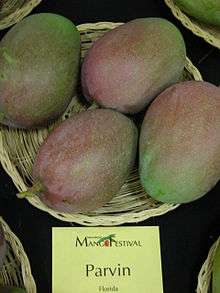Parvin (mango)
The 'Parvin' mango is a named commercial mango cultivar that originated in Southwest Florida.
| Mangifera 'Parvin' | |
|---|---|
| Genus | Mangifera |
| Species | Mangifera indica |
| Cultivar | 'Parvin' |
| Origin | Florida, US |
History
The original tree was reportedly grown from a Haden mango seed,[1] and was planted in 1940 on the property of Clint Fisk Parvin in Bradenton, Florida.[2] During the 1940s Parvin was submitted for evaluation to the Variety Committee of the Florida Mango Forum, which gave it a positive recommendation. Characteristics such as color, production and handling characteristics (due to its thick skin), and flavor made Parvin a potential commercial cultivar. While Parvin only saw limited commercial plantings in Florida, it is grown on a commercial basis in Puerto Rico. Parvin did not become a popular dooryard cultivar in Florida.
Description

The fruit are oval to oblong in shape and have a rounded apex, lacking a beak. The skin is thick and the color is yellow with red or crimson blush covering much of it at maturity. The fruit average a little over a pound in weight, and typically ripen from July to August in Florida.[3] The flesh is fiberless and has a deep orange color with a sweet flavor, and contains a monoembryonic seed. Parvin is known for producing many small, seedless fruit often referred to as "nubbins".
The trees are vigorous growers that will develop rounded and spreading, dense canopies.[4]
See also
References
- "Archived copy". Archived from the original on 2010-12-02. Retrieved 2012-10-31.CS1 maint: archived copy as title (link)
- http://www.fshs.org/Proceedings/Password%20Protected/1991%20Vol.%20104/47-48%20%28CAMPBELL%29.pdf
- http://edis.ifas.ufl.edu/mg216
- Campbell, Richard J. (1992). A Guide to Mangos in Florida. Fairchild Tropical Garden. p. 139. ISBN 0-9632264-0-1.